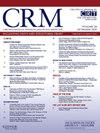自发性冠状动脉剥离并发心源性休克st段抬高型心肌梗死患者发病率和死亡率的性别差异
IF 1.9
Q3 CARDIAC & CARDIOVASCULAR SYSTEMS
引用次数: 0
摘要
背景:自发性冠状动脉夹层(SCAD)患者以st段抬高型心肌梗死(STEMI)并发展为心源性休克(CS)的性别差异数据有限。目的:描述伴有STEMI和CS的SCAD患者的预后,并概述男性和女性之间的差异。方法:我们查询了2016年1月至2020年12月美国全国再入院数据库(NRD),以确定SCAD合并STEMI并发CS的患者。我们比较了该队列中男性和女性的特征、趋势和结果。结果:在582,633例STEMI住院患者中,0.2%(1176例)患有SCAD,其中346例(29.4%)患有CS。男性和女性的中位年龄没有差异(64岁(IQR 57-71) vs. 63岁(IQR 49-72), p = 0.181)。男性有较高的既往心肌梗死(MI)患病率(14.2%比6.2%,p = 0.021)。SCAD合并AMI-CS患者的总死亡率为28.2%,男女之间无差异。SCAD合并CS并行冠脉搭桥的患者死亡率为20.3%。6.1%伴有STEMI和CS的SCAD患者采用了ECMO,生存率为49.9%。结论:SCAD合并CS (SCAD-CS)的男性和女性在基线特征、血运重建率或住院死亡率方面没有差异。SCAD-CS患者行冠脉搭桥的住院生存率约为80%。在该患者队列中,应考虑将冠脉搭桥作为一种血运重建方法。本文章由计算机程序翻译,如有差异,请以英文原文为准。
Gender disparity in morbidity and mortality among patients with ST-elevation myocardial infarction due to spontaneous coronary artery dissection complicated by cardiogenic shock
Background
There is limited data on gender differences among patients with spontaneous coronary artery dissection (SCAD) who present as ST-elevation myocardial infarction (STEMI) and develop cardiogenic shock (CS).
Objectives
To describe outcomes of SCAD patients presenting with STEMI and CS and outline the differences between men and women.
Methods
We queried the US Nationwide Readmissions Database (NRD) from January 2016 to December 2020 to identify patients with SCAD presenting with STEMI who developed CS. We compared the characteristics, trends, and outcomes between men and women in this cohort.
Results
Out of 582,633 hospitalizations with STEMI, 0.2 % (1176 patients) had SCAD, of which 346 (29.4 %) had CS. There was no difference in median age between men and women (64 years (IQR 57–71) vs. 63 years (IQR 49–72), p = 0.181). Men had a higher prevalence of prior myocardial infarction (MI) (14.2 % vs. 6.2 %, p = 0.021). The overall mortality rate of SCAD patients with AMI-CS was 28.2 %, with no difference between men and women. Patients with SCAD who had CS and underwent CABG had a mortality of 20.3 %. ECMO was used in 6.1 % of SCAD patients presenting with STEMI and CS, with a survival rate of 49.9 %.
Conclusion
There were no differences in the baseline characteristics, rates of revascularization, or in-hospital mortality between men and women who had SCAD complicated by CS (SCAD-CS). Patients with SCAD-CS patients who underwent CABG had around 80 % in-hospital survival. CABG should be considered as a method of revascularization in this patient cohort.
求助全文
通过发布文献求助,成功后即可免费获取论文全文。
去求助
来源期刊

Cardiovascular Revascularization Medicine
CARDIAC & CARDIOVASCULAR SYSTEMS-
CiteScore
3.30
自引率
5.90%
发文量
687
审稿时长
36 days
期刊介绍:
Cardiovascular Revascularization Medicine (CRM) is an international and multidisciplinary journal that publishes original laboratory and clinical investigations related to revascularization therapies in cardiovascular medicine. Cardiovascular Revascularization Medicine publishes articles related to preclinical work and molecular interventions, including angiogenesis, cell therapy, pharmacological interventions, restenosis management, and prevention, including experiments conducted in human subjects, in laboratory animals, and in vitro. Specific areas of interest include percutaneous angioplasty in coronary and peripheral arteries, intervention in structural heart disease, cardiovascular surgery, etc.
 求助内容:
求助内容: 应助结果提醒方式:
应助结果提醒方式:


